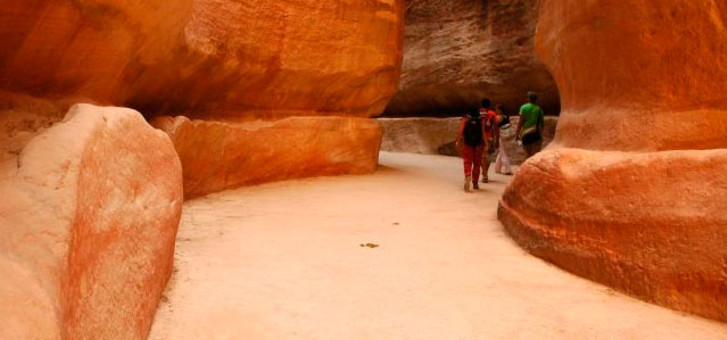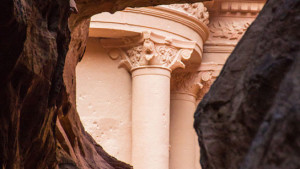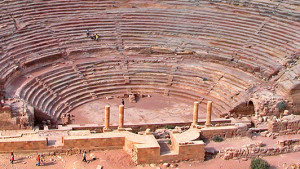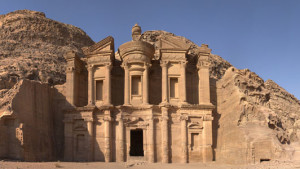The old city of Petra nestled in a fertile valley surrounded by rugged hills. The main entrance to the valley was by the Siq, a narrow ravine more than a kilometre in length. A wadi (dry riverbed) composed the floor of the ravine. When there was a sudden deluge of rain, a wall of water gushed through the ravine, sweeplng to their death any hapless travellers who happened to be there.
The Romans conquered Petra in I06 AD and among other developments they laid a paved road through the Siq. It was made of substantial blocks of stone which must have resulted in easy travelling for pedestrians, horse riders and chariots. Half way through the Siq a section of this paved road can still be seen.
From the time John Burckhart found the entrance to Perm In 1812 until recent times the only way to enter the lost ciy was by walking and riding. It seemed unthinkable to archaeologists and government authorities that internal combustion engines should ever desecrate the Siq, but the inevitable happened. Jeeps, cars and even trucks started roaring through the ravine.
More recently the government called a huIt to the reckless traffic but Jeeps are still available for those tourists who have physical infirmities. It is quite astonishing how many tourists do have physical infirmities. But it is still a rough ride. Now a Swiss team of archaeologists is proposing to thoroughly excavate whatever segments of the old Roman roadare still there and to rebuild the areas that have disappeared.
Needless to say, the proposal has not been hailed with joy by all archaeologists. Restoration of monuments, by putting back into position components that have been dislodged, is controversial enough, but rebuilding monuments with new material is objectionable to most archaeologists.
Sure, it gives the mindless public a good idea of what the original monument looked like. But in the first place it no longer looks like an ancient monument with all the new blocks of stone that have been added, and second, who is to say exactly how it looked originally. Casual tourists will have difficulty determining what is new and what is old, and it can even be confusing to scholars.
In the case of the Petra road it could be particularly objectionable. There will be too much temptation to allow unrestricted traflc to go roaring along the smooth highway and that would destroy the tranquillity of this incredible site. To walk through the silent Siq is an experience never to be forgotten. The rocky walls rising 100 metres above the wadi floor almost meet overhead in some places. The rainbow-coloured rocks transport the visitor into an awesome wonderland of colour and immensity.
It is to be hoped that the peace of Petra will not be shattered with the jarring noise of iron monsters.






